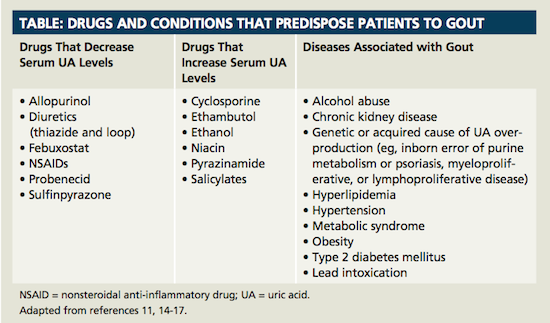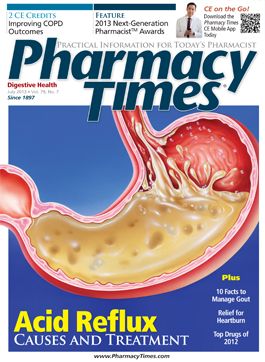Publication
Article
Pharmacy Times
A Bout of Gout: A Reign of Pain
Author(s):
Knowing these 10 facts can help manage patients with gout.
Knowing these 10 facts can help manage patients with gout.
Approximately 8.3 million Americans (3.9%) have gout pursuant to chronic hyperuricemia (elevated serum uric acid [UA]), making it the most common inflammatory arthritis. Some experts now consider it epidemic.1 Its prevalence almost doubled between 1990 and 1999, and it has continued to increase.2,3
What facts do pharmacists need to know to ensure best outcomes?
Fact 1. The main risk factor is a trio: diet, increasing age, and obesity.4-6 Our aging population and ongoing battle with obesity are probably responsible for gout’ s increasing prevalence.7,8 In individuals younger than 60 years, gout affects 7 to 9 times more men than women. After 60 years of age, its incidence is identical across genders.2,5
Fact 2. Early gout waxes and wanes. Symptomatic gout manifests as red, swollen, painful flares—often confused with cellulitis—followed by remission. In roughly 50% of patients, its onset starts with a severely inflamed first metatarsophalangeal joint (the big toe's largest joint).9 Early flares may also occur in the midfoot, ankle, heel, or knee. Later flares may move to the wrist, fingers, and elbow. Patients will report pressure sensitivity so severe that in addition to being unable to use the joint, covering it with just a sheet feels agonizing. Some patients also have fever, chills, and malaise. Untreated, gout flares can last days to several weeks, then wane, and recur again. The period between flares is called the intercritical segment.10
Fact 3. A gout attack is stage 2. Gout begins with asymptomatic uric acid (UA) deposits in joints—that is stage 1. Acute flares strike after 10 to 30 years of tissue deposition.11 During intercritical segments, UA continues to accumulate. After 10 years of intermittent disease, patients usually report persistent discomfort.4,10 Twenty-five percent of people who have elevated UA concentrations due to either UA underexcretion or overproduction will develop gout. Patients with UA concentrations of 7 to 8 mg/dL have a cumulative incidence of gout of about 3%; it rises to 22% if UA levels exceed 9 mg/dL.10 Some people who have normal UA levels can develop gout, however.
12
Fact 4. Monosodium urate monohydrate (MSU) crystals are to blame. MSU precipitates, migrates to joint spaces, and slowly damages surrounding soft tissue. Uncontrolled elevated UA can lead to tophi (MSU crystal deposits) in cooler tissues first—ears, finger joints, or elbows.4 Researchers believe exposure to substances that solubilize UA (especially drugs that alkalinize urine) increases tendency to develop gout.11 Changing serum UA concentrations affect soluble/crystallized UA equilibrium and dislodge MSU deposits. Subsequently, polymorphonuclear leukocytes devour the free crystals and activate inflammatory processes.13 Pharmacists should be aware that drugs or disease states that acutely increase or decrease serum UA levels can trigger acute flares, as can mechanical trauma 2,10 (Table 1).

Fact 5. Kidney stones (nephrolithiasis) may be a related condition. UA crystals in urine can increase calcium oxalate crystallization and increase the likelihood that they will lodge in the kidneys, causing extreme pain.11
Fact 6. The American College of Rheumatology (ACR) published its first guidelines for gout management in 2012 in 2 parts: approaches to hyperuricemia and treatment of acute attacks.12,18 ACR offered the following recommendations:
- Treatment goals should include pain relief, decreased inflammation, and symptomatic improvement.
- Patient education is essential and must cover diet, lifestyle, treatment objectives, and management of comorbidities.
- Target serum UA levels are 6 mg/ dL at a minimum, and 5 mg/dL if possible.
- For hyperuricemia, the xanthine oxidase inhibitors (XOIs) allopurinol, starting at 100 mg/day (lower for patients who have CKD), or febuxostat are first-line pharmacologic therapy. Titrate allopurinol to maintenance, even if it exceeds 300 mg/day. Probenecid is an alternative.
- If UA is still elevated after titrating the XOIs, add a uricosuric (probenecid or off-label use of losartan or fenofibrate). Remember to increase the allopurinol dose if probenecid is added.
- If an XOI plus a uricosuric fails, consider the biologic pegloticase.
Fact 7. Lifestyle changes are crucial. Lifestyle changes, especially losing weight and reducing alcohol (especially beer) consumption, reduce gout symptoms.4,19 Reducing consumption of purine-rich foods (meat [particularly organ meats], seafood, alcohol, and certain vegetables if they precipitated attacks in the past) and increasing consumption of low-fat dairy products and other vegetables are important. The ACR Guidelines group foods into avoid, limit, and encourage categories.12,20 Adequate hydration and weight loss reduces risk of recurrent attacks.2
Fact 8. Acute attacks need immediate attention—from the patient and from a care provider. Patients should rest affected joints for 1 to 2 days, applying ice for 15 to 20 minutes several times a day. Note that warm compresses can worsen pain.9 Treating with prescription nonsteroidal anti-inflammatory drugs (NSAIDs), corticosteroids, or oral colchicine is an appropriate first-line step. If the attack is severe or refractory, some combinations can be used.12,18
Fact 9. Always add anti-inflammatory prophylaxis to urate lowering. XOIs can cause acute gout flares due to redissolution of UA sequestered in tophi. Oral colchicine or low-dose NSAID therapy is appropriate first-line gout attack prophylaxis therapy. Colchicine interacts with strong and moderate cytochrome P450 CYP3A4 inhibitors, necessitating dose reductions. Dose reductions are also needed with concurrent P-glycoprotein inhibitors. Naproxen, indomethacin, and sulindac are FDA approved for acute gout, but other NSAIDs may be as effective. Cyclooxygenase 2 (COX-2) inhibitors are an option in patients with gastrointestinal contraindications or intolerance to NSAIDs. Corticosteroids can be used in patients with contraindications to NSAIDs or colchicine. Prophylaxis should be continued until gout symptoms resolve and/or the serum UA target is achieved.18
Fact 10. Know and share information about risks and benefits. Patients who carry the HLA—B*5801 allele (eg, highest in Han Chinese and Thai patients and Koreans with stage 3 or worse chronic kidney disease) are at very high risk for severe cutaneous adverse reactions to allopurinol.21 Advise patients to avoid aspirin as an analgesic, but continue cardioprotective aspirin if they take it. Patients taking the uricosurics probenecid or sulfinpyrazone should drink 1.5 to 2 L of water daily.9,10 Be sure to check for drug interactions, and counsel (1) every patient taking colchicine that its dosing schedule changed recently (just 2 doses now) and (2) patients taking drugs that interact with colchicine need lower doses. Colchicine can increase the rhabdomyolysis risk in patients taking digoxin, statins, or fibrates.22
Ms. Wick is a visiting professor at the University of Connecticut School of Pharmacy and a freelance clinical writer.
References:
- Zhu Y, Pandya BJ, Choi HK. Prevalence of gout and hyperuricemia in the US general population: the National Health and Nutrition Examination Survey 2007—2008. Arthritis Rheum. 2011;63:3136-3141.
- Weaver AL. Epidemiology of gout. Cleve Clin J Med. 2008;75:S9-S12.
- Crittenden DB, Pillinger MH. New therapies for gout. Annu Rev Med. 2013;64:325-337.
- Centers for Disease Control and Prevention. Gout. www.cdc.gov/arthritis/basics/gout.htm. Accessed June 9, 2013.
- Kramer HM, Curhan G. The association between gout and nephroliasis: the National Health and Nutrition Examination Survey III, 1988-1994. Am J Kidney Dis. 2002;40:37-42.
- Roubenoff R, Klag MJ, Mead LA, Liang KY, Seidler AJ, Hochberg MC. Incidence and risk factors for gout in white men. JAMA. 1991;266:3004-3007.
- Flegal KM, Carroll MD, Ogden CL, Johnson CL. Prevalence and trends in obesity among US adults, 1999-2000. JAMA. 2002;288:1723-1727.
- US Department of Health and Human Services. Surgeon General’s call to action to prevent and decrease overweight and obesity. Rockville, MD: US Government Printing Office; 2001.
- Schumacher HR, Chen LX. Gout and other crystal arthropathies. In: Fauci AS, Braunwald E, Kasper DL, et al. Harrison’s Principles of Internal Medicine. 17th ed. New York, NY: McGraw-Hill; 2011:chap 327.
- Sanders S, Wortmann RL. Gout. In: Imboden JB, Hellmann DB, Stone JH. Current Rheumatology Diagnosis & Treatment. 2nd ed. New York, NY: McGraw-Hill; 2011:chap 45.
- Wortmann RL. Disorders of purine and pyrimidine metabolism. In: Fauci AS, Braunwald E, Kasper DL, et al. Harrison’s Principles of Internal Medicine. 17th ed. New York, NY: McGraw-Hill; 2011:chap 353.
- Khanna D, Fitzgerald JD, Khanna PP, et al; American College of Rheumatology. 2012 American College of Rheumatology guidelines for management of gout: part 1: systematic nonpharmacologic and pharmacologic therapeutic approaches to hyperuricemia. Arthritis Care Res (Hoboken). 2012;64:1431-1446.
- Ernst ME, Clark EC, Hawkins DW. Gout and hyperuricemia. In: DiPiro JT, Talbert RL, Yee GC, Matzke GR, Wells BG, Posey LM. Pharmacotherapy: A Pathophysiologic Approach. 7th ed. New York, NY: McGraw-Hill; 2008:chap 96.
- Bhole V, de Vera M, Rahman MM, Krishnan E, Choi H. Epidemiology of gout in women: fifty-two—year followup of a prospective cohort. Arthritis Rheum. 2010;62:1069-1076.
- Pillinger MH, Goldfarb DS, Keenan RT. Gout and its comorbidities. Bull NYU Hosp Jt Dis. 2010;68:199-203.
- Brook RA, Forsythe A, Smeeding JE, Lawrence EN. Chronic gout: epidemiology, disease progression, treatment and disease burden. Curr Med Res Opin. 2010;26:2813-2821.
- Roddy E, Doherty M. Epidemiology of gout. Arthritis Res Ther. 2010;12:223.
- Khanna D, Khanna PP, Fitzgerald JD, et al; American College of Rheumatology. 2012 American College of Rheumatology guidelines for management of gout: part 2: therapy and antiinflammatory prophylaxis of acute gouty arthritis. Arthritis Care Res (Hoboken). 2012;64:1447-1461.
- Choi HK, Atkinson K, Karlson EW, Willett W, Curhan G. Alcohol intake and risk of incident gout in men: a prospective study. Lancet. 2004;363:1277-1281.
- Choi HK, Atkinson K, Karlson EW, Willett W, Curhan G. Purine-rich foods, dairy and protein intake, and the risk of gout in men. N Engl J Med. 2004;350:1093-1103.
- Tassaneeyakul W, Jantararoungtong T, Chen P, et al. Strong association between HLA-B*5801 and allopurinol-induced Stevens-Johnson syndrome and toxic epidermal necrolysis in a Thai population. Pharmacogenet Genomics. 2009;19:704-709.
- Colcrys [package insert]. Philadelphia, PA: AR Scientific, Inc; 2012.







